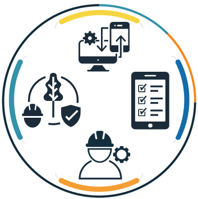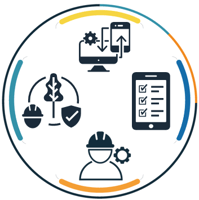6 min read
An Overview Of Scope 1, 2 and 3 Emissions And Why They Matter
By: Ideagen DevonWay on November 8, 2022

As greenhouse gas emissions continue to rise, so too does the importance of understanding Scope 1, 2 and 3 emissions. Defined by the Greenhouse Gas Protocol – the internationally recognized standard for measuring and reporting greenhouse gas emissions – the three scopes break down the sources of emissions an organization or community produces, both directly and indirectly throughout operations and the value chain.
Scope 1, 2 and 3 emissions are becoming a larger part of the conversation for organizations, investors and governments alike around the globe, as they provide a standard for how entities calculate (and are accountable to) their own greenhouse gas emissions. Understanding Scope 1, 2 and 3 emissions has never been more important – and, in the future, the measurements of these emissions might be one of the most critical components to an organization’s success.
About greenhouse gas emissions
When looking at Scope 1, 2 and 3 emissions, it’s important to first understand greenhouse gases, or GHGs, as a whole, including where they come from and why they are a threat to our environment. In short, GHGs trap heat in the earth’s atmosphere. These gases include carbon dioxide, methane, nitrous oxide and fluorinated gases. While these gases are naturally occurring, human activity has led to their unhealthy buildup, creating an unnatural warming of the planet.
According to the United States Environmental Protection Agency (EPA), particular economic activities have led to the increases in global greenhouse gas emissions:
- Electricity and heat production: Accounts for 25% of global GHG emissions, including through the burning of coal, oil and natural gas.
- Industrial: Accounts for 21% of emissions through the burning of fossil fuels at facilities for energy.
- Agriculture, forestry, and other land use: Creates 24% of global GHG emissions from cultivating crops and livestock, as well as deforestation.
- Transportation: Makes up 14% of emissions through fossil fuels burned for transportation by air, land and sea.
- Buildings: Creates 6% of emissions due to energy generation and burning fuels for heat and cooking.
- Other energy: Accounting for 10% of global greenhouse gas emissions, these sources refer to all emissions from the energy sector that are not directly associated with electricity or heat production, such as transportation, fuel extraction, processing and refining.
Looking across the globe, in 2020 the top emitters of carbon dioxide (the most prevalent GHG) were China, the United States, India, Russia and Japan.
By the year 2050, Climate scientists believe that global carbon dioxide emissions must be reduced by 85% from their year 2000 levels in order to protect our ecosystem.
While many policies and organizations have been created to fight climate change caused by GHG emissions, the Greenhouse Gas Protocol in particular was founded in 1998 to establish a standard for how the world measures and manages greenhouse gas emissions. Now as the internationally accepted standard, the GHG Protocol has accounting and reporting tools to be used in both the private and public sectors to promote a low emissions economy worldwide. Among these standards are Scope 1, 2 and 3 emissions.
Understanding Scope 1, 2 and 3 emissions
When looking at greenhouse gases, there are different types of emissions a company might be creating (directly or indirectly) that they are responsible for. These include the seven major greenhouse gases: CO2, CH4, N2O, HFCs, PFCs, SF6, and NF3.
In order to provide organizations a way to inventory their emissions throughout their operations and value chain, the GHG Protocol created Scope 1, 2 and 3 emissions to segment the three main types that can be controlled:
Scope 1 - Direct Emissions
Scope 1 emissions are those created directly by an organization, through company-owned assets or controlled resources. These include emissions associated with running vehicles, boilers and furnaces, and factory fumes. Other less obvious examples might be the emissions created by use of a backup diesel generator used to protect a data center owned by the organization, or an unintentional leak of greenhouse gases from refrigerants in an HVAC system.
Scope 2 - Indirect Emissions
Scope 2 emissions are emissions created from the generation of energy that is purchased by the organization. These emissions happen at sources controlled or owned by another entity but are used by an organization in its operations. These emissions are typically electricity, heat or steam.
Scope 3 - Value Chain Emissions
Scope 3 emissions account for all indirect emissions (that aren’t included in Scope 2) that occur in the value chain of an organization. While these emissions are not directly controlled by the organization, the organization’s value chain indirectly leads to these outputs.
Scope 3 emissions factors include:
- Upstream activities:
- Purchased goods and services
- Capital goods
- Fuel and energy related activities
- Transportation and distribution
- Waste generated in operations
- Business travel
- Employee commuting
- Leased assets
- Downstream activities
- Transportation and distribution
- Processing of sold products
- Use of sold products
- End-of-life treatment of sold products
- Leased assets
- Franchises
- Investments
While often the most difficult to quantify, Scope 3 emissions often represent the majority of an organization’s total GHG emissions. While they are not under the organization’s control, its practices and decisions (such as which supplier or vendor to work with) can influence the results of these emissions. Learn more in the GHG Protocol’s “Corporate Value Chain (Scope 3) Accounting and Reporting Standard.”
How to measure emissions
Understanding Scope 1, 2 and 3 emissions is just part of the bigger picture when it comes to organizations’ understanding, measuring and amending their GHG emissions. According to the EPA, there are four key steps for developing a GHG inventory:
- Review accounting standards and methods, determining organizational and operational boundaries, and choosing a base year.
- Collect data and quantify GHG emissions (using Scope 1, 2 and 3 standards).
- Develop a GHG Inventory Management Plan to formalize data collection procedures.
- Set a GHG emission-reduction target, and track and report progress.
The EPA has created a guide to support organizations through this process. As noted in this document and through the GHG Protocol, creating a high-quality, credible inventory of an organization’s GHGs relies on five principles, as the data must be: relevant, complete, consistent, transparent and accurate.
To support this baseline, and improve emissions long term, it’s critical to have reliable software to track the organization’s emissions. Measuring emissions’ sources for each scope – from purchased gases to use of electricity to employee business travel – is vital to understanding an organization’s emissions picture, and reporting on it.
A strong software system should umbrella the organization’s operations, to break down silos and provide both a birds-eye view of emissions as well as micro data for each scope. As more and more organizations work toward becoming carbon neutral, meaning they achieve and maintain net zero GHG emissions, reliable data provided by a comprehensive software suite will be key. Plus, using a controlled system of record will create succinct reporting, allowing for efficiencies and mitigating risk, as well as providing documentation to easily and quickly pass along to investors and showcase to consumers.
What’s to come
With sustainability top-of-mind, the GHG emissions of an organization will continue to grow in importance for investors and consumers. While some U.S. businesses are already required to report their GHG emissions to investors or through sustainability reports, there aren’t federal requirements for this type of reporting yet in the United States. However, a new SEC proposed rule is in the works that would require certain climate-related disclosures, including GHG emissions.
The future is focused on sustainability, and organizations need to understand how they can start, or continue, to grow their Environmental, Social and Governance (ESG) practices. A big part of that picture is understanding Scope 1, 2 and 3 emissions, and setting up a system that will not only help track the organization’s emissions, but accelerate their improvement.
How DevonWay can support
Wherever your organization may be in its ESG initiatives, DevonWay has the tools to bring it all together. With DevonWay’s ESG & Sustainability software, you can both track ESG metrics and implement performance initiatives to achieve your goals. Leading standards are built-in to guide organizations through what they need to track, so you can measure, report and improve your metrics with confidence. Request a demo today to understand how we can support you in calculating your GHG emissions, and so much more.
Related Posts
New SEC Greenhouse Gas Reporting Rules Passed
On March 6, the U.S. Securities and Exchange Commission (SEC) adopted new rules for climate-related...
How New California Climate Law Could Impact Companies Worldwide
A new law in California was recently passed that will require 5,000-plus companies that do business...
Top 5 Reasons to Improve Your ESG Reporting Now
If your organization hasn’t started thinking about how to improve ESG reporting, it’s time to make...





